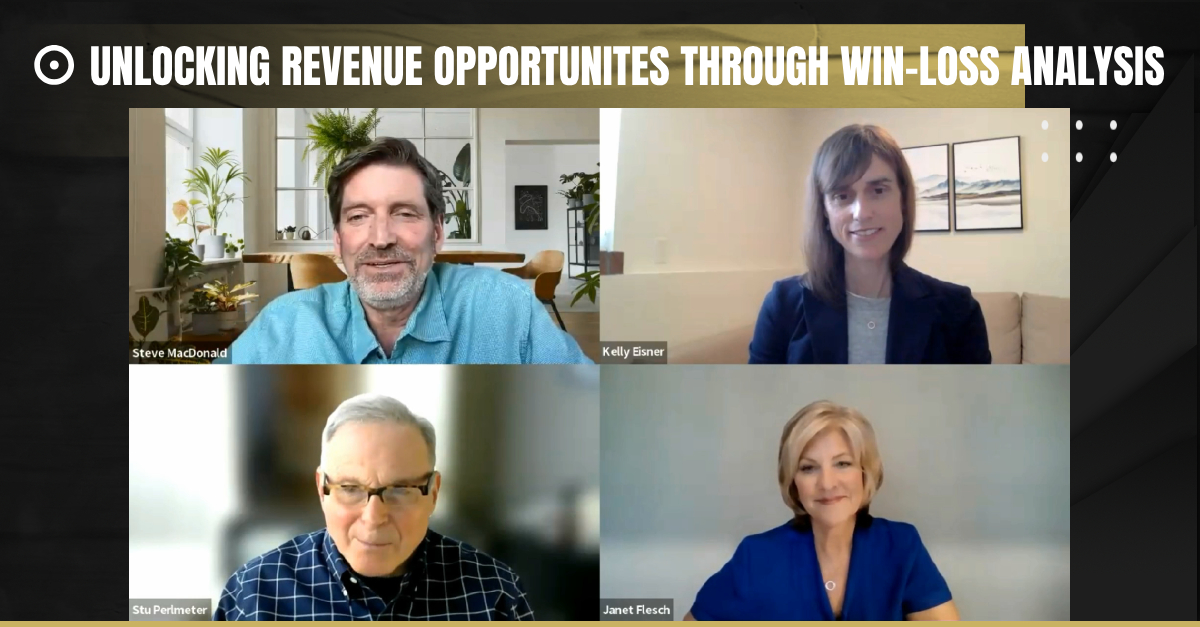Unlocking Revenue Opportunities Through Win-Loss Analysis
Stu Perlmeter, founder of 1st Resource, Janet Flesch (Practice Lead), and Kelly Eisner (Interview Analyst) discuss the power of qualitative win-loss analysis. They reveal insights on buyer journeys, pricing, sales streamlining, product development, and marketing improvement. Storytelling and buyer trust are key revenue drivers.

It’s time to expect more from B2B content marketing. Traditional content marketing solves problems, where thought leadership sparks conversations at every stage of the buyer’s journey. Why shouldn’t the very act of creating thought leadership content also be a direct lead generation or sales activity itself? In a world where B2B buyers are trending more and more toward a self-serve buyers journey, marketing needs to play a bigger role in starting conversations earlier in the process.
As B2B founders, we simplify your path to being recognized as industry experts with the highest sales closing rates.
The win-loss analysis offers qualitative insights into the buyer journey and decision process, particularly beneficial in complex B2B sales. It uncovers competitive insights, pricing concerns, sales process improvements, and product development opportunities through one-on-one interviews. This method fosters open dialogue, allowing buyers to share experiences and inform marketing strategies by validating target segments and refining positioning and messaging.
“When done properly, win-loss analysis can deliver deep and surprising insights that help build the roadmap to winning more and the success that every marketing and sales organization strives for.” – Stu Perlmeter
Key Takeaways:
- The win-loss analysis provides a qualitative approach to understanding the buyer journey and decision process, offering deep insights into critical drivers of wins and losses.
- Traditional data analytics methods and surveys often need to be revised to capture the complexity of B2B sales, especially in high-dollar, complex environments.
- The win-loss analysis uncovers competitive insights, pricing issues, sales process improvements, and product development opportunities by conducting in-depth, one-on-one interviews with buyers.
- The storytelling aspect of win-loss analysis allows buyers to share their experiences in a safe space, leading to more open and valuable insights.
- The Win-loss analysis helps inform marketing by validating target segments, uncovering awareness and perception issues, and refining positioning and messaging strategies.
Listen to the full podcast or watch it on YouTube directly below.
Article: “Unlocking Revenue Opportunities Through Win-Loss Analysis”
From a podcast interview with Stu Perlmeter, Founder at 1st Resource, with 1st Resource’s Practice Lead for Customer Insights, Janet Flesch, and Interview Analyst, Kelly Eisner
Understanding the Value of Win-Loss Analysis
Understanding the factors contributing to wins and losses in B2B sales is crucial for driving revenue growth. Traditional win-loss analysis methods often rely on data analytics and surveys. Still, these approaches fail to capture the complexity of the buyer journey and the qualitative insights that can be gained from in-depth conversations with customers.
Stu Perlmeter, founder of 1st Resource, explains that win-loss analysis goes beyond simply identifying how sales teams may have made mistakes or missed opportunities. Instead, it provides a comprehensive view of the entire sales and marketing spectrum, allowing companies to learn from every element of their team and improve their performance.
Janet Flesch, the Practice Lead for Customer Insights at 1st Resource, emphasizes the importance of retracing the customer journey from the prospect’s perspective. Companies can gain valuable insights into the critical drivers of wins and losses by conducting in-depth, one-on-one telephone interviews with key decision-makers. These insights can then inform marketing, sales, and product development strategies, leading to increased revenue and stronger customer relationships.
Uncovering Competitive Insights
One of the most significant advantages of win-loss analysis is the ability to gather competitive insights directly from buyers. During the interview process, customers often share information about their experiences with competitors, providing companies with a unique perspective on how they compare to the competition.
Kelly Eisner, who conducts and analyzes win-loss interviews at 1st Resource, explains that buyers are often willing to share details about pricing, proposals, and the value they perceive from different providers. This information can help companies understand how their pricing compares to competitors and whether they effectively communicate their value proposition.
Additionally, win-loss analysis can show how competitors position themselves and what messaging resonates with buyers. By understanding how competitors are perceived and what solutions they offer, companies can refine their positioning and messaging to differentiate themselves better and meet the needs of their target audience.
Insights for Marketing: Targeting, Awareness, and Perception
The win-loss analysis provides valuable insights for marketing teams across various areas, including targeting, awareness, and perception. By retracing the customer journey, companies can refine their ideal customer profile (ICP) and validate whether prospects fit within their target segment.
Janet shares an example of a client who learned from the win-loss analysis, that they needed to refine their ICP and identify the specific role of the decision-maker within the target company. This insight allowed them to focus their marketing efforts on the finance side rather than the operations side, resulting in more effective targeting and messaging.
The win-loss analysis also helps companies understand how prospects become aware of their company and competitors and how they perceive their brand throughout the selection process. This information can inform marketing spend allocation, positioning, and messaging strategies. Companies can tailor their messaging and content to better resonate with their target audience by understanding the salient aspects and differentiating factors important to prospects.
Pricing and Value: Aligning with Buyer Expectations
Another critical area where win-loss analysis provides insights is pricing and value. By understanding how buyers perceive pricing about the value they receive, companies can ensure their pricing reflects their true worth and aligns with buyer expectations.
Kelly shares an example where a client discovered they were underpricing their services, leading prospects to question the company’s understanding of their needs and capabilities. This insight allowed the client to adjust their pricing strategy and communicate their value more effectively, ultimately improving their win rate.
Win-loss analysis can also uncover opportunities for companies to streamline their sales process and address gaps in their product capabilities. By understanding buyers’ specific needs and pain points, companies can make informed decisions about product development and prioritize resources accordingly.
Conclusion
The win-loss analysis offers a qualitative approach to understanding the buyer journey and decision-making process, providing deep insights into the critical drivers of wins and losses. By conducting in-depth interviews with key decision-makers, companies can uncover competitive insights, refine their targeting and messaging strategies, and align their pricing and value proposition with buyer expectations.
The power of win-loss analysis lies in its ability to capture the buyer’s perspective in a safe and open environment, allowing for valuable storytelling and sharing experiences. This qualitative approach complements traditional data analytics and surveys, providing companies with a comprehensive understanding of their market and the opportunities for revenue growth.






